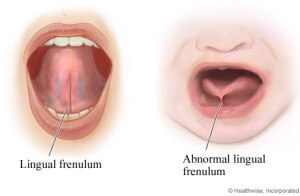What is tongue-tie?
Tongue-tie is a birth defect that affects 4-11% of newborn babies. It’s more common in boys than girls.
Normally, the tongue is loosely attached to the base of the mouth with a piece of skin called the lingual frenulum.
In babies with tongue-tie, this piece of skin is unusually short and tight, restricting the tongue’s movement. This prevents the baby feeding properly and also causes problems for the mother.

How is tongue-tie treated?
Treatment is not necessary if your baby has a piece of skin connecting the underside of their tongue to the floor of their mouth, but they can feed without any problems. If feeding is affected, the tongue-tie needs to be divided.
Tongue-tie division
Tongue-tie division involves cutting the short, tight piece of skin connecting the underside of the tongue to the floor of the mouth. It’s a simple and almost painless procedure that usually resolves feeding problems straight away.
How tongue-tie division is carried out
In babies that are only a few months old, division of tongue-tie is usually performed without any anaesthetic (painkilling medication), or with a local anaesthetic that numbs the tongue.
A general anaesthetic is usually needed for older babies with teeth, which means they’ll be asleep during the procedure.
The baby’s head is held securely while sharp, sterile scissors are used to snip the tongue-tie. Some practitioners may use a laser instead of scissors.
The procedure only takes a few seconds, and you can start feeding your baby immediately afterwards. Some babies sleep through it, while others cry for a few seconds. In small babies, being cuddled and fed is more important than painkillers.
There should be little blood loss, though some bleeding is likely. A white patch may form under the tongue, which takes 24 to 48 hours to heal, but doesn’t bother the baby.
Tongue-tie in older children and adults
Untreated tongue-tie may cause no problems as a child gets older, and any tightness may resolve naturally as the mouth develops with age.
However, some cases can persist, and may cause problems such as speech difficulties and difficulty eating certain foods.
Speak to your GP if you’re concerned you or your child may be experiencing problems caused by tongue-tie.
Tongue-tie division can be carried out in older children and adults, although this is usually done under general anaesthetic and may involve using stitches to close the resulting wound under the tongue.
